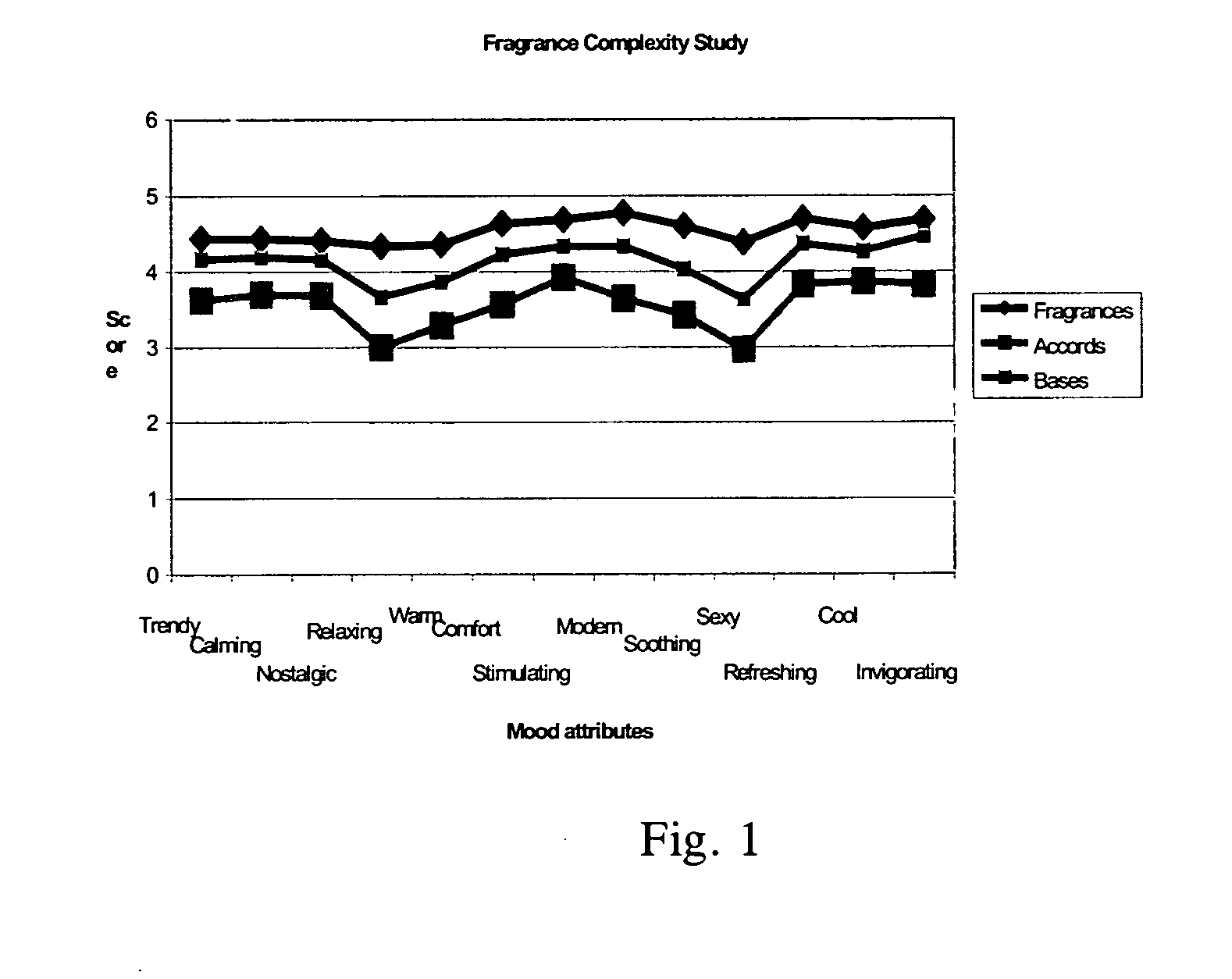Fragrance compositions
a composition and fragrance technology, applied in the field of fragrance compositions, can solve the problems of poor memory of odours, less memory of words and pictures, and difficulty in expressing joy, and achieve the effects of improving the memory of perfume ingredients, reducing the difficulty of perfumers to feel joy, and reducing the number of perfumers
- Summary
- Abstract
- Description
- Claims
- Application Information
AI Technical Summary
Benefits of technology
Problems solved by technology
Method used
Image
Examples
example 1
A Study on Perfume Complexity
[0082]A total of 20 different odours were evaluated in a consumer sniff test. The odours were grouped according to their complexity into 3 groups: complex finished fragrances, mixes of fragrance materials known as accords, and simple fragrance mixes or bases. The consumers were asked to smell a subset of the odours and score against the attributes: trendy, calming, nostalgic, relaxing, warm, comforting, stimulating, modem, soothing, sexy, refreshing, cool, energising. The results shown in FIG. 1 indicate that the more complex fragrances outperformed their simpler analogues across each of these attributes.
example 2
[0083]The fragrance compositions detailed in Table 1 were prepared and subjected to a variety of test protocols. Those fragranced labelled 11 through to 14 are fragrance compositions according to the invention, whereas those labelled C1 through C4 are comparatives. Analysis of these compositions according to the group classifications given here is shown below.
TABLE 1Fragrance compositionsFRAGRANCE COMPOSITIONSI1I2I3I4C1C2C3C4INGREDIENTGROUPw / w %w / w %w / w %w / w %w / w %w / w %w / w %w / w %ALLYL AMYL GLYCOLATE(Q)IMP0.00.00.60.00.20.00.00.0ALLYL AMYL GLYCOLATE 10% DPGIMP0.00.00.01.10.00.00.00.0ALLYL CYCLOHEXYLPROPIONATEHMP0.00.00.00.00.00.00.00.0ALLYL HEPTANOATEHMP0.00.00.00.00.00.00.00.0ALLYL IONONE(G)HMR0.00.00.00.10.00.00.00.0AMBER CORE(TM)(Q)HMI0.00.00.60.70.00.00.00.0AMBERLYN SUPER(TM)(Q)HMI0.00.00.00.30.00.00.00.0AMBERLYN SUPER(TM)(Q) 10% DPGHMI2.00.02.10.00.00.01.00.0AMBRETTOLIDE(TM)(G)N / A0.00.00.00.00.00.00.00.0AMYL SALICYLATEN / A0.00.00.00.00.00.01.02.0ANISIC ALDEHYDERMP0.00.00.00.00.00...
example 3
[0084]Salivary cortisol provides a convenient route to assess the degree of stress throughout the day. In the below protocol two perfumes were subjected to a cortisol test largely based on that disclosed in WO 2002 / 049629. The perfume of the invention 13, with an aromatic fougere scent and perceived as invigorating, was found not to promote higher cortisol levels during a working day than did a control procedure excluding perfume. A comparative perfume C4, a spicy oriental type perceived as relaxing, was found to produce a significantly higher level of cortisol depression, as expected.
Protocol:
[0085]A group of healthy subjects (3 male and 2 female, known as subjects A to E) participated in trials over several days to assess the relaxation / invigorating effect of smelling two fragrances as indicated by changes in salivary cortisol levels. Assessments took place at least 4 hours after waking each day.[0086]1) Initial saliva sample provided (approx 1 ml)[0087]2) Smelling of fragrance (r...
PUM
 Login to View More
Login to View More Abstract
Description
Claims
Application Information
 Login to View More
Login to View More - R&D
- Intellectual Property
- Life Sciences
- Materials
- Tech Scout
- Unparalleled Data Quality
- Higher Quality Content
- 60% Fewer Hallucinations
Browse by: Latest US Patents, China's latest patents, Technical Efficacy Thesaurus, Application Domain, Technology Topic, Popular Technical Reports.
© 2025 PatSnap. All rights reserved.Legal|Privacy policy|Modern Slavery Act Transparency Statement|Sitemap|About US| Contact US: help@patsnap.com

